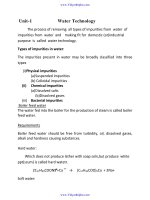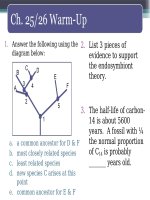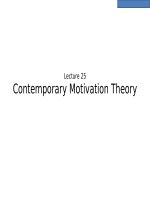Lecture 25 running water
Bạn đang xem bản rút gọn của tài liệu. Xem và tải ngay bản đầy đủ của tài liệu tại đây (7.14 MB, 75 trang )
Today:
Chapter 15: Running Water
Announcements:
Please do not call Aurora on her
cell phone number. If you need
to make contact, do so
by email. Thanks!
Homework assignment: Review
Interlude E: The hydrological cycle
and complete assignment. Will be
handed out on Monday at the beginning
of class and will be due on Wednesday.
Quiz next Wednesday covering:
- Interlude D: Fossils and Evolution
- Chapter 12: Deep Time
(Historical Geology)
- Chapter 16: Mass wasting
- Chapter 17: Running water
oceans
dams
plants
s
r
e
ir v
evaporation
lakes
rain
sediments
& soil
mountains
snow
To think about for Monday’s
homework: The hydrological cycle
Describe how these 10 elements are
interrelated in the hydrological cycle.
Chapter 15: Running Water
Topics for today:
Hydrological cycle
Surface run-off
Sheet wash
Channel flow
Discharge = Velocity x Channel Area
Turbulent and laminar flow
Stream transport processes
Drainage basins and divides
Base level and stream profiles
Processes of stream erosion
How streams carve their channels
Processes of stream deposition
Downstream changes in channel
form and bahavior
Effects of changing base level
Running Water: Why Care?
Running Water:
Why care?
Running Water:
Why care?
Hydrological Cycle & Running Water
Hydrological cycle (see video):
Continuous cycling of water between the atmosphere, oceans
and land, driven by gravity and energy from the Sun.
Running water is the most effective agent of erosion
and the dominant external factor in shaping the
Earth’s surface.
Important factors that affect the ability
of running water to alter the landscape:
Rainfall
Surface runoff
Rate of evaporation
Earth’s Water Inventory
Sources of water that sustain stream flow….
Fig. 17.02
W. W. Norton
RUNNING
WATER
Process Begins with Surface Runoff
“Sheet flow”: Thin sheets of water accumulate
and flow over surface.
Controlled by: Intensity/duration of rainfall.
Soil texture.
Soil saturation.
Slope angle.
Vegetation
Initiation of stream erosion: Sheet flow
then accumulates and self-organizes into
rivulets and small channels that eventually
feed into streams.
Major River Systems of the Earth
RUNNING
WATER
Stream Valleys
Most common surface landform on Earth!
V-shaped near headwaters,
with many water falls and
rapids. Slotted canyons may
form where bedrock is
easily eroded.
Widen downstream due to
erosion of by slope wash
and gravity.
Fig. 17.19
Stephen Marshak
Major River systems consist of a hierarchy
of tributaries that range from small rivulets
to streams to major rivers…
Fig. 17.05 b
W. W. Norton
Drainage patterns are strongly controlled
by the structure of the underlying rock units…
Fig. 17.04abcd
W. W. Norton
Drainage basins are areas that are drained
by the same stream system…
Fig. 17.06
W. W. Norton
Drainage basins
are separated by
drainage divides,
where streams
on either side flow
opposite directions.
Drainage basins are areas that are drained
by the same stream system…
Fig. 17.06
W. W. Norton
Drainage basins
are separated by
drainage divides,
where streams
on either side flow
opposite directions.
Major Drainage Basins of North America
Fig. 17.07
RUNNING
WATER
Stream Profiles
Longitudinal Stream Profile: A cross sectional
view that shows how the slope of a stream channel
changes along its course.
Longitudinal stream profile
Fig. 17.05 a
W. W. Norton
Cross sectional profiles at
different points along
stream course.
RUNNING
WATER
Base Level
Base level:
The downward limit to which a stream
will erode its channel.
Temporary base level:
Along a stream gradient, this is a
temporary level to which a stream will
erode its channel. Example: Lake
Ultimate base level:
Sea level.
Fig. 17.21 a
W. W. Norton
Fig. 17.18 a
W. W. Norton









